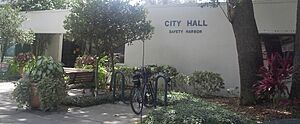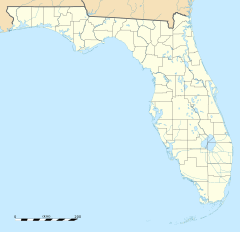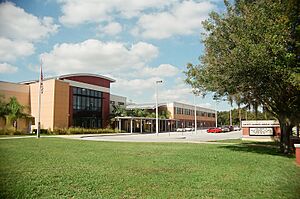Safety Harbor, Florida facts for kids
Quick facts for kids
Safety Harbor, Florida
|
||
|---|---|---|
| City of Safety Harbor | ||

Safety Harbor City Hall
|
||
|
||
| Motto(s):
Home of the Mineral Springs
|
||
| Country | United States of America | |
| State | Florida | |
| County | Pinellas | |
| Settled | 1823 | |
| Incorporated | 1917 | |
| Area | ||
| • Total | 5.10 sq mi (13.21 km2) | |
| • Land | 4.92 sq mi (12.75 km2) | |
| • Water | 0.18 sq mi (0.46 km2) | |
| Elevation | 20 ft (6 m) | |
| Population
(2020)
|
||
| • Total | 17,072 | |
| • Estimate
(2021)
|
16,987 | |
| • Density | 3,467.10/sq mi (1,338.66/km2) | |
| Time zone | UTC-5 (Eastern (EST)) | |
| • Summer (DST) | UTC-4 (EDT) | |
| ZIP code |
34695
|
|
| Area code(s) | 727 | |
| FIPS code | 12-62425 | |
| GNIS feature ID | 0290124 | |
Safety Harbor is a city located on the west side of Tampa Bay in Pinellas County, Florida, United States. It was first settled in 1823 and officially became a city in 1917. In 2020, about 17,072 people lived there.
Contents
History of Safety Harbor
The area where Safety Harbor is located has been home to people for a very long time, even since the Stone Age. In 2008, a spearhead that was 6,000 years old was found in Marshall Street Park.
The first people known to live here when Spanish explorers arrived were the Tocobaga people. They lived in villages around Tampa Bay and used the natural resources around them for survival. They made pottery and used tools from copper, shells, and stone. The Tocobaga were also known for building large mounds of earth for ceremonies and to bury their dead. Many of these mounds were destroyed in the early 1900s as the area grew. However, one important ceremonial mound can still be seen today in Safety Harbor's Phillippe Park. Shells from these mounds were even used to pave some of the city's streets.
In the early 1500s, Spanish explorers like Pánfilo de Narváez (in 1528) and Hernando de Soto (in 1539) came to this area. Safety Harbor was once known by other names like Worth's Harbor and Green's Springs. The first person to claim land here was Count Odet Philippe, a French nobleman. He is believed to have brought the grapefruit to Florida in 1823.
The name "Safety Harbor" came about in the early 1700s. At that time, pirates were a big problem in the area. Once ships reached this part of the bay, they were safe from pirate attacks. Because of this, people started calling it a "Safe Harbor."
The Famous Springs
Safety Harbor is famous for its historic Espiritu Santo Springs, which means "Springs of the Holy Spirit." These are natural mineral springs. In 1539, the Spanish explorer Hernando de Soto gave them this name. He was supposedly looking for the legendary "Fountain of Youth," which was believed to make people young again. Before the Spanish arrived, the Tocobaga and Timuquan tribes likely used these springs for fishing and bathing.
In the 1900s, water from the Espiritu Santo Springs was bottled and sold. Later, a health spa and hotel were built over the springs. Today, it's known as the Safety Harbor Resort and Spa and is a popular place for visitors in Pinellas County. In 1964, the U.S. Department of the Interior named the site a Historical Landmark. In 1997, it also became a Florida Heritage Landmark.
Safety Harbor Geography
The city of Safety Harbor is located on the west side of a waterway also called Safety Harbor, which connects to Tampa Bay.
The city covers a total area of about 5.1 square miles (13.2 square kilometers). Most of this area, about 4.9 square miles (12.7 square kilometers), is land. The rest, about 0.1 square miles (0.46 square kilometers), is water.
Safety Harbor Population
| Historical population | |||
|---|---|---|---|
| Census | Pop. | %± | |
| 1920 | 429 | — | |
| 1930 | 765 | 78.3% | |
| 1940 | 694 | −9.3% | |
| 1950 | 894 | 28.8% | |
| 1960 | 1,787 | 99.9% | |
| 1970 | 3,103 | 73.6% | |
| 1980 | 6,461 | 108.2% | |
| 1990 | 15,124 | 134.1% | |
| 2000 | 17,203 | 13.7% | |
| 2010 | 16,884 | −1.9% | |
| 2020 | 17,072 | 1.1% | |
| 2021 (est.) | 16,987 | 0.6% | |
| U.S. Decennial Census | |||
According to the 2020 United States census, Safety Harbor had 17,072 people living there. There were 6,903 households and 4,781 families in the city.
Arts and Culture in Safety Harbor
Safety Harbor Public Library
The Safety Harbor Public Library started in 1938. It was created by the Women's Civic Club of Safety Harbor with money from a government program called the Works Progress Administration (WPA). The first librarian, Daisy Cahow, was appointed in November 1938.
The library first operated out of the Community House. To get books, the Women's Civic Club would borrow 50 books at a time from the state. As the library grew, it needed more space. In 1946, Dr. Salem Baranoff, who owned the Safety Harbor Spa, gave two empty lots for a new library building. Construction started in 1949, and the new library opened in November of that year.
The Women's Civic Club continued to run the library. However, by 1978, it became hard for them to pay for everything. So, they gave the property to the City of Safety Harbor in exchange for yearly funding. The city fully took over running the library in October 1980.
As more people moved to Safety Harbor, the library needed to expand again. A new building was constructed in 1993 at its current location, opening on October 1, 1994. In February 2024, work began to add a second floor to the library. The Safety Harbor Public Library is also part of the Pinellas Public Library Cooperative, which means it works with other libraries in the area.
Education in Safety Harbor
There are two public schools in Safety Harbor:
- Safety Harbor Elementary School, for students in grades one through five.
- Safety Harbor Middle School, for students in grades six through eight.
Safety Harbor Infrastructure
A CSX railroad line runs through Safety Harbor. This line connects Tampa to St. Petersburg. Passenger trains used this line until 1984.
Notable People from Safety Harbor
Many interesting people have lived in Safety Harbor, including:
- Matt Geiger, a professional basketball player in the NBA.
- Alan Lomax, who collected and wrote about folk music.
- Dave Martinez, a professional baseball player and manager in Major League Baseball (MLB).
- Taffy Nivert, a singer and songwriter from the band Starland Vocal Band.
- Robin Zander, a musician from the band Cheap Trick.
- Calvin Heimburg, a professional disc golfer.
Images for kids
-
Tocobaga Indian Mound in Philippe Park
See also
 In Spanish: Safety Harbor para niños
In Spanish: Safety Harbor para niños






